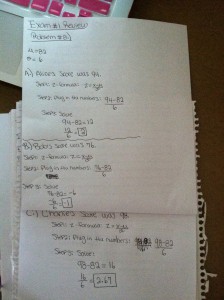Study Guide for Problem #16
Melissa Alteon
Question #16: A survey claims that a college graduate from Smith College can expect an average starting salary of $42,000. Fifteen Smith College graduates, drawn from normally distributed population, had an average starting salary of $40,800 with a standard deviation of $2,250. At the 1% level of significance, can we conclude that the average starting salary of the graduates is significantly less than $42,000?
Step 1: State the claim. Identify the null Hypothesis H0 and alternative hypothesis Ha.
Ho = µ = $42,000
Ha = µ ≠ $42,000
Step 2: Specify the level of significance . The level of significance gives the area of the rejection region(s)
α= .01, because 1% is equivalent to .01
Step 3: Describe the tails of the test. Sketch the rejection region(s)
The test is a two-tailed test since it is NOT equal to $42,000 that only means that it could be either GREATER than $42,000 or LESS than $42,000.
Step 4: Determine the degree of freedom d.f.= n-1
n=15, therefore n-1 would be 15-1 which equals 14
d.f. = 14
Step 5: Determine the critical value(s) using the t-distribution table.
This table is “Table 5- t-Distribution” and how you would determine the critical value is by reading the table left to right. We know that the d.f. = 14 and the test is a two-tailed test and that = .01 so following this method you descend from the value of alpha and you should have gotten
z= 2.977
Step 6: Find the t-value of the test static (from your sample).
z= (x-bar) – µ(x-bar)/ σ(x-bar)
µ (x-bar)= µ, µ= $42,000
σ (x-bar)= , s/ (square root of n)
s= $2250 and n= 15
s/(square root of n) = 580.95
x-bar = $40,80
z= ($40,800-$42,000)/580.95
z=-2.07
Step 7: Make a decision to reject or fail to reject the null hypothesis.
In this case the null hypothesis cannot be rejected because the t-value collected from the sample -2.07 does not lie outside the critical value instead it lies in between the critical values of -2.977 and +2.977. In other words it is not in the rejection area.
Step 8: Interpret the decision in the context of the original claim.
Therefore, A college graduate from Smith College can expect an average starting salary of $42,000 and we can conclude that the average starting salary of the graduates is less than $42,000.
Step 4: Determine the degree of freedom d.f.= n-1
n=15, therefore n-1 would be 15-1 which equals 14
d.f. = 14
Step 5: Determine the critical value(s) using the t-distribution table.
This table is “Table 5- t-Distribution” and how you would determine the critical value is by reading the table left to right. We know that the d.f. = 14 and the test is a two-tailed test and that = .01 so following this method you descend from the value of alpha and you should have gotten
z= 2.977
Step 6: Find the t-value of the test static (from your sample).
= $42,000
, s= $2250 and n= 15
= 580.95
= $40,800
Step 7: Make a decision to reject or fail to reject the null hypothesis.
In this case the null hypothesis cannot be rejected because the t-value collected from the sample does not lie outside the critical value instead it lies in between the critical values of -2.977 and +2.977
Step 8: Interpret the decision in the context of the original claim.
Therefore, A college graduate from Smith College can expect an average starting salary of $42,000 and we can conclude that the avg starting salary of the graduates is less than $42,000.





